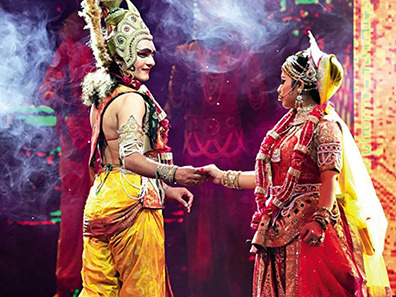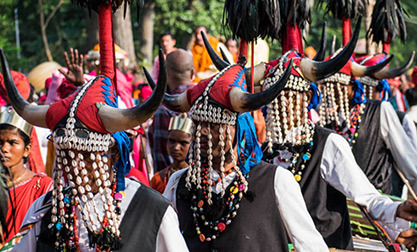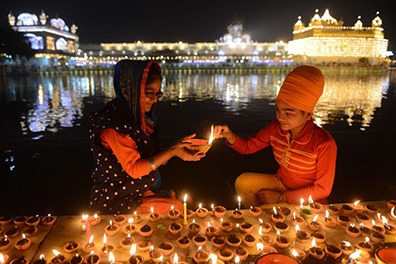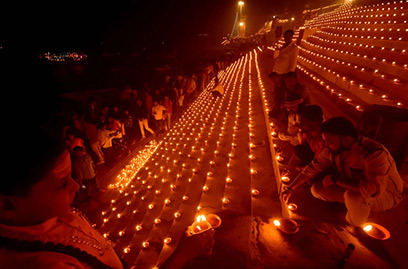Light a Lamp of Happiness and Prosperity
Happy Diwali!
|
Read. Imagine. Travel
Namaste! With the Indian borders gradually opening up for the tourists and travel thoughts resurfacing in our minds, on a high note, we are indulging in festivities keeping in mind the new norms.
Visit a destination during a local festival and virtually everyone in the city or town can be seen in a celebratory mood. Exploring the local culture of any region offers a peek into the most authentic aspects of life and what else could be the best time than any of the festivals of the land. The same goes for India, a country known for its numerous colourful and magnificent festivals. The read in this edition is about a series of festivals, which are interlinked and celebrated one after another but with the same underlying message of victory of good over evil. Yes, you got it right it is the ‘Diwali Festival’!
Watch a short video on one of the most significant festivals of India, Diwali, or the Festival of Lights. It's a five day celebration that includes food, fireworks, coloured sand, and special candles and lamps.

Around early October, India starts getting immersed in a festive mood with the onset of Navratri Festival (festival of 09 nights) & Durga Puja (the feminine form of divinity), followed by Dussehra. After which the celebrations engulfs the country in festive decorations, songs, dancing, and gluttonous feasts, to intensify the celebratory mood, as we celebrate the festival of lights, ‘Diwali’ with warmth and joy!
While Gujarat is the place to indulge in the Navratri celebrations, especially for its Garba (a dance form), which is typically performed during the Navratra festival in honour of goddess Durga, the grandness of Durga Puja can be seen in West Bengal, especially in Kolkata.
Watch how Durga Puja is celebrated in West Bengal in this beautiful video.
HOW DUSSEHRA IS CELEBRATED IN DIFFERENT PARTS OF INDIA?
DELHI

Like many parts of North India, the festival is celebrated on the tenth day, preceded with nine days of Navratri festival . What makes Delhi the excellent choice to witness this festival is its nine day long theatrical representation of the entire journey of Lord Rama from his birth to exile and then returning to the kingdom (locally called Ramlila).
On the 10th day, a procession is carried out with artists representing Rama and other characters of the Epic Ramayana. The procession is followed by burning of the effigies of ten-headed demon Ravana along with other demons.
INTERESTING FACT: Ramlila, which is a dramatic re-enactment of Lord Rama’s life, started in Delhi in 1800s. In 2018, UNESCO declared the Ramlila festivities as Intangible cultural heritage of humanity.
KULLU

Unlike in other parts of India, where Dussehra marks the concluding of Navratri festival, in Kullu, Himachal Pradesh, it marks the first day of the seven-day long festival. The festival here begins with a procession on decorated chariots taking the idol of Lord Raghunath (as lord Rama is locally called) across the town with the rhythmic playing of drums and other musical instruments. The next six days are full of devotion, prayers, folk dances, rituals, traditions, and celebrations. The festival concludes with a bonfire symbolizing burning of Ravana's kingdom, Lanka (locally called Lanka Dahan).
The festival here is believed to be celebrated since the 17th century and is known for its vibrant chariot procession, divine music, and numerous cultural performances thus attracting thousands of people across the globe. It is also admired as one of the best 'International festival' of India.
INTERESTING FACT: Nati dance (a traditional folk dance of Himachal Pradesh), performed during the Kulu Dussehra in Oct 2015 was listed in Guinness world records for having the largest number of participants in any dance form (9892 participants).
MYSORE

Mysore celebrates the festival marking the victory of Goddess Chamundeshwari (local name of goddess Durga) over demon king, after a battle of nine days. The Mysore Palace and other important buildings in the city are decorated with lights and visited by royals and locals alike. The day is celebrated with cultural performances, sports competitions, food festivals, military parades etc.
The highlight of the festival is the jumbo safari on the concluding tenth day, wherein the procession is carried out on elaborately decorated elephants with golden howdahs (a seat for riding on the back of an elephant). Watch the beauty of this festival in this short video.
|
BASTAR
 Unlike other parts of the country, Bastar in Chhattisgarh does not celebrate the victory of good over evil or triumph of Lord Rama over demon Ravana, but offers gratitude to the native Goddess, Devi Danteshwari, on Dussehra.
Unlike other parts of the country, Bastar in Chhattisgarh does not celebrate the victory of good over evil or triumph of Lord Rama over demon Ravana, but offers gratitude to the native Goddess, Devi Danteshwari, on Dussehra.
Another uniqueness of the celebration here is that the festival goes on for 75 days thus making it one of the longest festivals of the world. Around 30 different tribes congregate during the festival in traditional attires, wherein each tribe performs different tasks on different days.
INTERESTING FACT: A two storied chariot (for procession) is built every year with sal wood exclusively for the Bastar Dusshera and it is one of the highlights of the festival.
As mentioned earlier, Dussehra interestingly marks the beginning of the preparations for another major festival of India - Diwali.
After defeating the demon king Ravana in Lanka, Lord Rama arrived back in his kingdom Ayodhya on the 20th day post his victory. The day also marked an end to his 14 years long exile. The entire kingdom was lit up with earthen lamps to welcome him back and celebrate his grand victory. Since then, the festival of Diwali is celebrated exactly 20 days after Dussehra. As there are different versions for Dussehra, so are for Diwali. Another belief says that on this day, Goddess Laxmi (Goddess of wealth) came out due to the churning of the cosmic ocean of milk by gods and demons. So, people also worship Goddess Laxmi, on this day for gaining wealth and prosperity. In most parts of India, people celebrate this festival by exchanging gifts and sweets, decorating homes and business establishments with lamps and lights, offering prayers, and choose this day to start new ventures. The festival has a different significance in different parts of India. But the underlying message is the same everywhere:" victory of truth over evil, light over darkness and knowledge over ignorance". Let’s now explore some places where the Diwali festival is celebrated differently than other parts of India:
KOLKATA:

Diwali in Kolkata coincides with goddess ‘Kali’ (destroyer of Evil) puja, which is the second-largest festival (after Durga Puja) celebrated in Kolkata. Thousands of devotees visit the temples to offer prayers and seek blessings of the goddess.
Many community marquees are set up with idols of goddess to accommodate as many devotees as possible. For the festive mood, many cultural performances are also organized in the marquees.
As goddess Kali is the main deity of this festival, one can visit any of the local temples: Dakshineswar Temple, Kalighat, Adyapeeth temple, Belur Math, and Thanthania Kalibari dedicated to the goddess to see & enjoy the rituals. The religious places, sites, streets, houses, river banks etc. are all illuminated with lamps. Fireworks display all over and people with colorful clothes in the decorated markets reflect the city's festive spirit.
INSIDER TIP: On Diwali, while the decorated marquees are the main attraction in Kolkata, one can also watch the spectacular evening Ganga Aarti ceremony at Howrah’s Ramakrishnapur Ghat.
GOA:

Goa is known for its happening beaches. Very few know that one can also choose to visit Goa to witness Diwali celebrations. Unlike other parts of India, Diwali celebrations in Goa starts a day before other cities (and locally known as NARAKA CHATURDASHI). As per the legend, Lord Krishna beheaded the demon Naraka who used to terrorize the local people, in the wee hours and later he took a bath with scented oils.
Similarly the tradition is followed and on this day, people burn the effigy of demon Naraka to mark the victory of good over evil and light over the darkness. Later, people take a bath with scented oils, wear new clothes and exchange sweets and start preparing for the Diwali celebrations.
AMRITSAR:

In Amritsar, Diwali is also celebrated as 'Bandh Chhor Divas’ (means day of liberation) by Sikh community. The celebrations are dedicated to the sixth Guru of Sikhs (Guru Hargobind Singh Ji), who was released from the confinement of the Mughal emperor on this day.
Like everywhere, prayers and decorations start right from the morning, and by the evening, all parts of the city along with the famed Golden Temple complex is illuminated with lights. It is hard to describe the dazzling view of the Golden Temple in words.
VARANASI:

When you talk about Diwali, how can one miss the grand old celebration in one of the world's oldest cities, Varanasi! Soon after 15 days of the grand Diwali celebration, Varanasi celebrates Dev Diwali (or Diwali of the Gods), on the 15th lunar day of Kaartik month. According to legends, this is the day when Lord Shiva defeated the Tripurasura (a demon) and to celebrate his triumph, the gods lit oil lamps. It is an auspicious day when all the gods are believed to descend from heaven to Lord Shiva's town Kaashi (Varanasi) on the banks of the Ganges to celebrate Dev Diwali.
It is a beautiful five days long festival where almost all the 87 Ghats in Varanasi are decorated with thousands of diyas (lamps)! Believe us, it is a sight to behold!
Every festival has an underlying message for society and is celebrated to keep reminding of the path one needs to follow. Celebrate the festivals of India with us and experience the origin of existing customs and beautiful traditions while you visit the country. We, at Indo Asia Tours, are all about the handcrafted tours, memories, and moments you take out of your trip, and believe us, this escapade will be a life-changing one! Wishing you a very Happy Diwali!
|
Virtual Destination Training Program
|
 Thank you, patrons, for reposing faith in our destinations and enquiring for customised virtual destination awareness training programs. We are proud to conduct them successfully so far and are looking forward to hold similar virtual destination awareness training programs for your team or yourself or a virtual tour for your clients. Let us know the destination of your interest along with your convenient date / time and we will be happy to set up a program for you.
Thank you, patrons, for reposing faith in our destinations and enquiring for customised virtual destination awareness training programs. We are proud to conduct them successfully so far and are looking forward to hold similar virtual destination awareness training programs for your team or yourself or a virtual tour for your clients. Let us know the destination of your interest along with your convenient date / time and we will be happy to set up a program for you.
Send Request
|
Please feel free to write back to us at marketing@indoasiatours.com to share our thoughts on customized journeys covering the Indian subcontinent or take time to visit our website https://www.indoasia-tours.com. Be sure we will prepare the best program to make a memorable trip for your esteemed clients!
|
|



 Unlike in other parts of India, where Dussehra marks the concluding of Navratri festival, in Kullu, Himachal Pradesh, it marks the first day of the seven-day long festival. The festival here begins with a procession on decorated chariots taking the idol of Lord Raghunath (as lord Rama is locally called) across the town with the rhythmic playing of drums and other musical instruments. The next six days are full of devotion, prayers, folk dances, rituals, traditions, and celebrations. The festival concludes with a bonfire symbolizing burning of Ravana's kingdom, Lanka (locally called Lanka Dahan).
Unlike in other parts of India, where Dussehra marks the concluding of Navratri festival, in Kullu, Himachal Pradesh, it marks the first day of the seven-day long festival. The festival here begins with a procession on decorated chariots taking the idol of Lord Raghunath (as lord Rama is locally called) across the town with the rhythmic playing of drums and other musical instruments. The next six days are full of devotion, prayers, folk dances, rituals, traditions, and celebrations. The festival concludes with a bonfire symbolizing burning of Ravana's kingdom, Lanka (locally called Lanka Dahan).
 Mysore celebrates the festival marking the victory of Goddess Chamundeshwari (local name of goddess Durga) over demon king, after a battle of nine days. The Mysore Palace and other important buildings in the city are decorated with lights and visited by royals and locals alike. The day is celebrated with cultural performances, sports competitions, food festivals, military parades etc.
Mysore celebrates the festival marking the victory of Goddess Chamundeshwari (local name of goddess Durga) over demon king, after a battle of nine days. The Mysore Palace and other important buildings in the city are decorated with lights and visited by royals and locals alike. The day is celebrated with cultural performances, sports competitions, food festivals, military parades etc.
 Unlike other parts of the country, Bastar in Chhattisgarh does not celebrate the victory of good over evil or triumph of Lord Rama over demon Ravana, but offers gratitude to the native Goddess, Devi Danteshwari, on Dussehra.
Unlike other parts of the country, Bastar in Chhattisgarh does not celebrate the victory of good over evil or triumph of Lord Rama over demon Ravana, but offers gratitude to the native Goddess, Devi Danteshwari, on Dussehra.
 Diwali in Kolkata coincides with goddess ‘Kali’ (destroyer of Evil) puja, which is the second-largest festival (after Durga Puja) celebrated in Kolkata. Thousands of devotees visit the temples to offer prayers and seek blessings of the goddess.
Diwali in Kolkata coincides with goddess ‘Kali’ (destroyer of Evil) puja, which is the second-largest festival (after Durga Puja) celebrated in Kolkata. Thousands of devotees visit the temples to offer prayers and seek blessings of the goddess.
 Goa is known for its happening beaches. Very few know that one can also choose to visit Goa to witness Diwali celebrations. Unlike other parts of India, Diwali celebrations in Goa starts a day before other cities (and locally known as NARAKA CHATURDASHI). As per the legend, Lord Krishna beheaded the demon Naraka who used to terrorize the local people, in the wee hours and later he took a bath with scented oils.
Goa is known for its happening beaches. Very few know that one can also choose to visit Goa to witness Diwali celebrations. Unlike other parts of India, Diwali celebrations in Goa starts a day before other cities (and locally known as NARAKA CHATURDASHI). As per the legend, Lord Krishna beheaded the demon Naraka who used to terrorize the local people, in the wee hours and later he took a bath with scented oils.
 In Amritsar, Diwali is also celebrated as 'Bandh Chhor Divas’ (means day of liberation) by Sikh community. The celebrations are dedicated to the sixth Guru of Sikhs (Guru Hargobind Singh Ji), who was released from the confinement of the Mughal emperor on this day.
In Amritsar, Diwali is also celebrated as 'Bandh Chhor Divas’ (means day of liberation) by Sikh community. The celebrations are dedicated to the sixth Guru of Sikhs (Guru Hargobind Singh Ji), who was released from the confinement of the Mughal emperor on this day.
 When you talk about Diwali, how can one miss the grand old celebration in one of the world's oldest cities, Varanasi! Soon after 15 days of the grand Diwali celebration, Varanasi celebrates Dev Diwali (or Diwali of the Gods), on the 15th lunar day of Kaartik month. According to legends, this is the day when Lord Shiva defeated the Tripurasura (a demon) and to celebrate his triumph, the gods lit oil lamps. It is an auspicious day when all the gods are believed to descend from heaven to Lord Shiva's town Kaashi (Varanasi) on the banks of the Ganges to celebrate Dev Diwali.
When you talk about Diwali, how can one miss the grand old celebration in one of the world's oldest cities, Varanasi! Soon after 15 days of the grand Diwali celebration, Varanasi celebrates Dev Diwali (or Diwali of the Gods), on the 15th lunar day of Kaartik month. According to legends, this is the day when Lord Shiva defeated the Tripurasura (a demon) and to celebrate his triumph, the gods lit oil lamps. It is an auspicious day when all the gods are believed to descend from heaven to Lord Shiva's town Kaashi (Varanasi) on the banks of the Ganges to celebrate Dev Diwali.
 Thank you, patrons, for reposing faith in our destinations and enquiring for customised virtual destination awareness training programs. We are proud to conduct them successfully so far and are looking forward to hold similar virtual destination awareness training programs for your team or yourself or a virtual tour for your clients. Let us know the destination of your interest along with your convenient date / time and we will be happy to set up a program for you.
Thank you, patrons, for reposing faith in our destinations and enquiring for customised virtual destination awareness training programs. We are proud to conduct them successfully so far and are looking forward to hold similar virtual destination awareness training programs for your team or yourself or a virtual tour for your clients. Let us know the destination of your interest along with your convenient date / time and we will be happy to set up a program for you.







